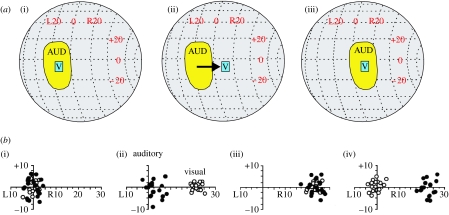Figure 3.
Visual experience shapes the developing auditory localization pathway in the barn owl (Tyto alba). (a) Effects of prism rearing on the auditory spatial receptive fields of neurons in the optic tectum. (i) Visual (V) and auditory (AUD) receptive fields are normally in close correspondence. (ii) Placing prisms that displace the visual field to the right by 23° disrupts the alignment of these receptive fields. (iii) After young owls have worn the prisms for eight weeks, the auditory receptive field has shifted so that it becomes realigned with the visual receptive field. Adapted from Knudsen & Brainard (1991). (b) Adjustment of auditory orienting responses in a prism-reared owl. Head-orienting responses to visual (open circles) or auditory (filled circles) targets plotted with respect to the location of the stimulus. Owls normally make accurate head turns towards either stimulus. Prisms immediately shift the visual responses, but have no effect on the auditory responses. However, after 42 days of experience with the prisms, the auditory responses have shifted to match the optical displacement of the visual field, presumably as a consequence of the changes that take place in the optic tectum. When the prisms are removed, normal visual responses are restored, although it takes several weeks for the auditory orienting responses to recover ((i) before prisms, (ii) after 1 day with prisms, (iii) after 42 days with prisms and (iv) prisms removed). Adapted from Knudsen & Knudsen (1990).

